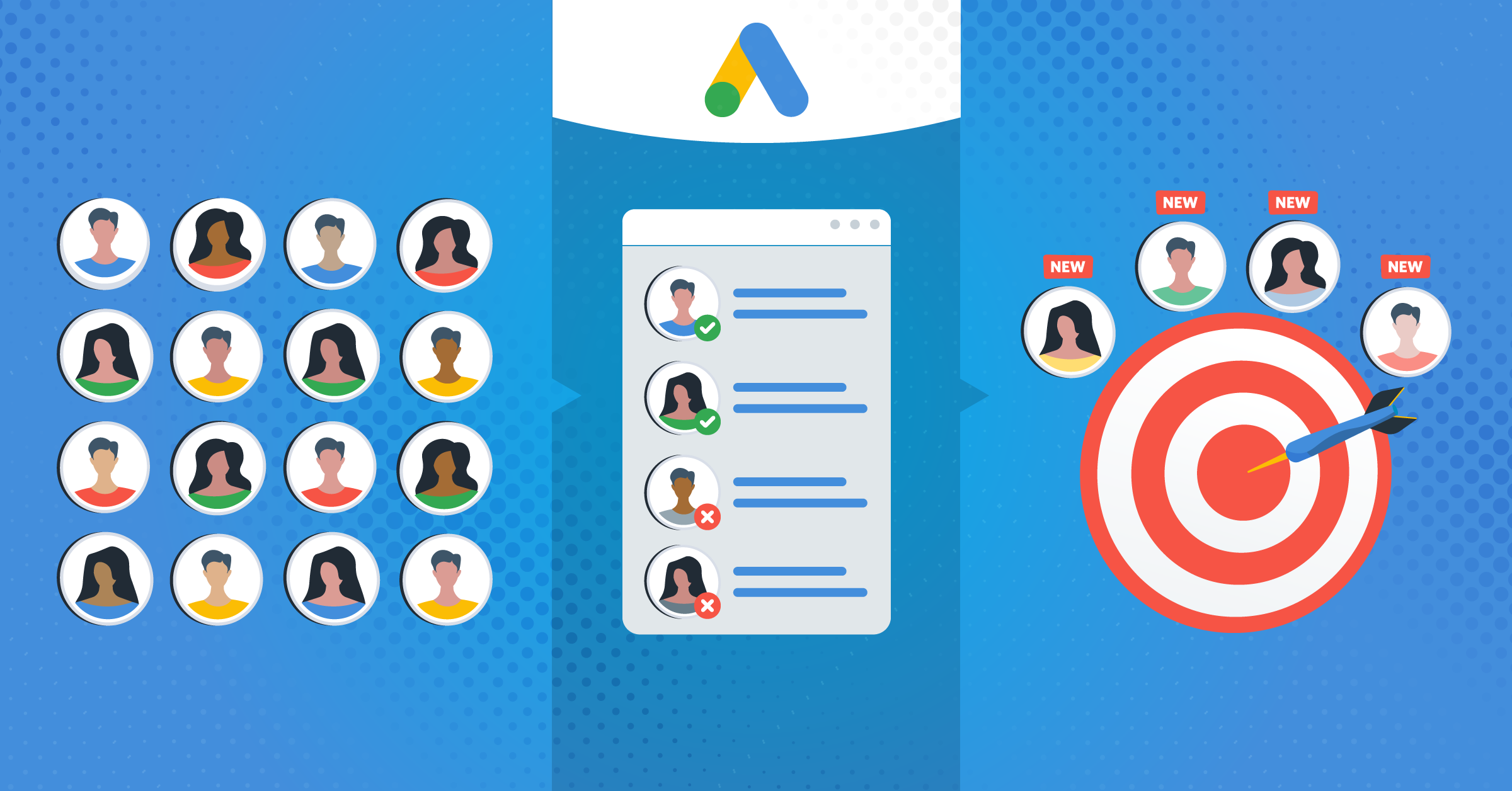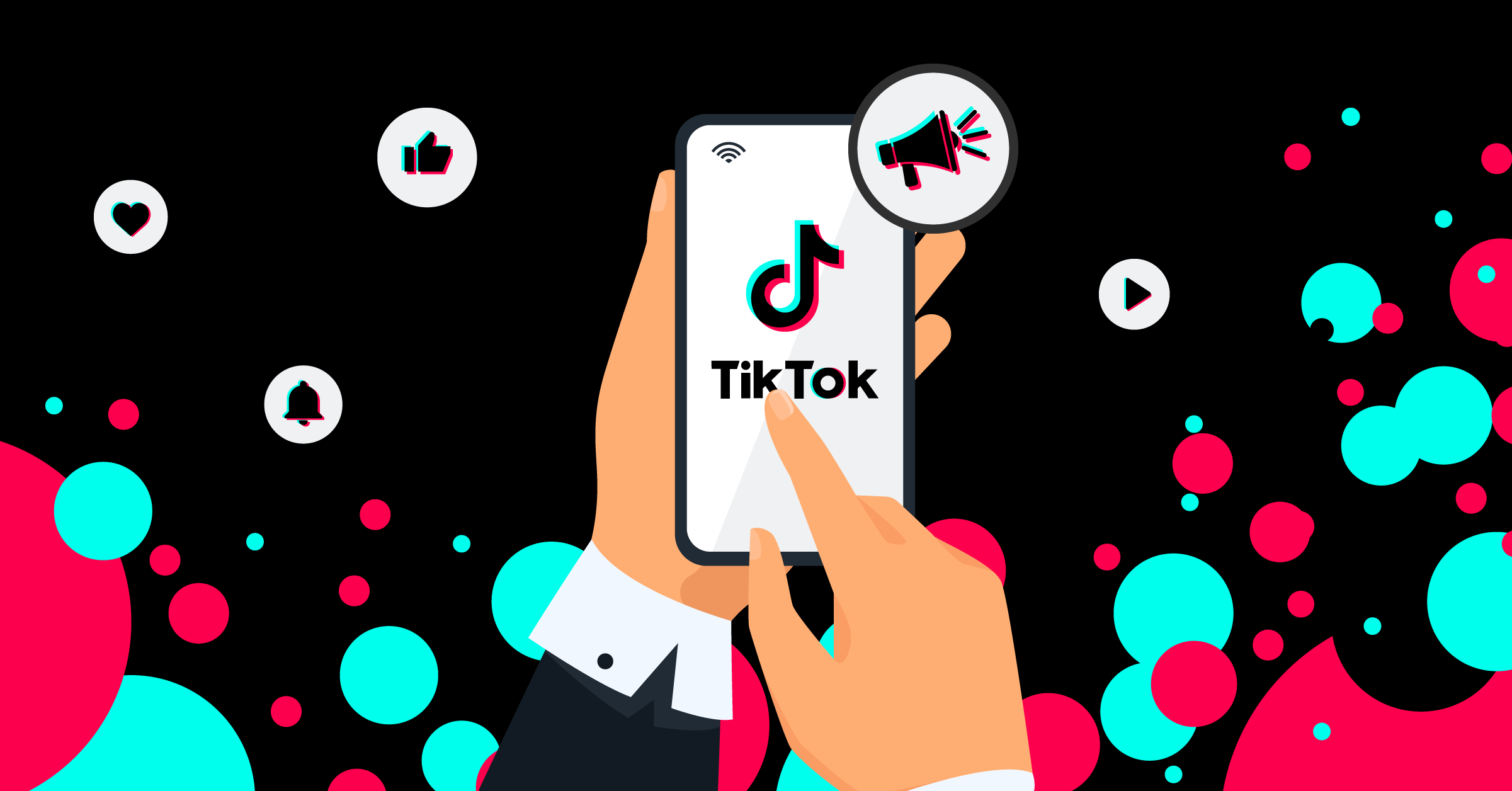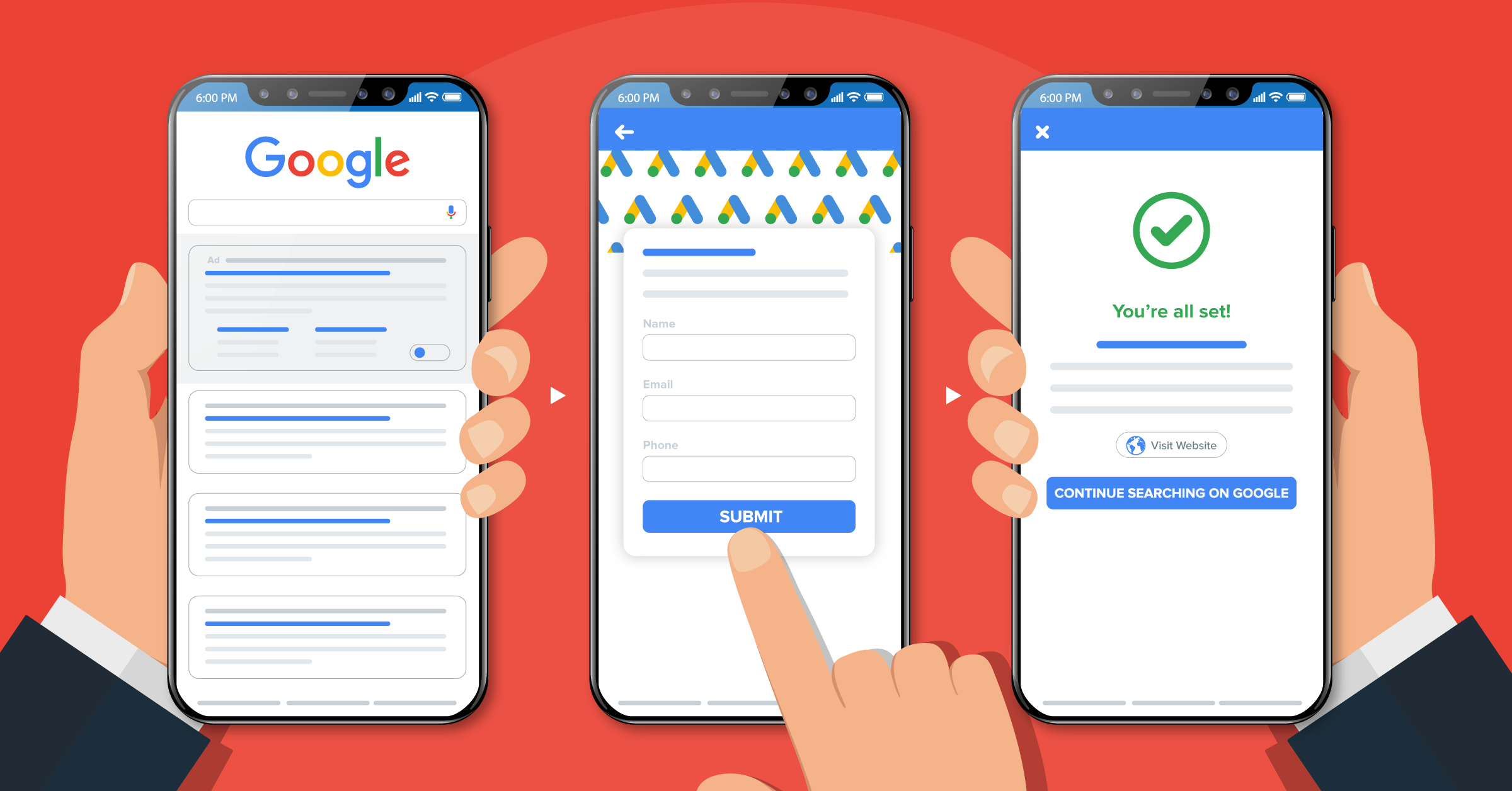
Every business owner knows that setting a strong lead generation strategy helps attract high-quality prospects. However, generating high-quality leads is not easy. In this article, we are going to talk about this issue and how to address it.
- Reasons to use Google lead form extensions
- Google Ads automation and LeadsBridge as a Google Premier Partner
- What are Google Ads lead form extensions?
- YouTube Lead Ads available in YouTube video action campaigns
- Using Lead Forms in Google Discovery Campaigns
- What are Google Ads enhanced conversions for leads?
- Key takeaways
In this article, you’ll learn all you need to know about Google lead form ads, as well as some Google Ads best practices and examples to follow. Additionally, you will discover how LeadsBridge’s integrations, as a Google Premier Partner, help you automate your advertising experience.
Reasons to use Google lead form extensions
One of the main challenges of acquiring leads is meeting consumers where they are. For many years, mobile users have accounted for approximately two-thirds of web traffic worldwide.
Moreover, fewer people are using laptops to browse the internet or social media sites. Currently, 96.3% of mobile internet users connect to social networks through mobile devices.
The traditional process of generating leads by redirecting people to a landing page, where they have to fill out multi-field forms before submitting their contact information, has become obsolete.
This process is an obstacle to higher conversions and financially costly. If you hope to see any kind of success with this method, you’ll have to use a good form builder.
Apart from the forms, slow-loading landing pages are a real curse for advertisers.
They increase the bounce rate by 40% and decrease the conversion rate by 7%. To address this issue, advertising publishers such as Facebook, LinkedIn, and Google have been rolling out new solutions for lead generation, such as native lead ads.

Native lead generation ads are designed specifically for targeting audiences while mobile navigation. The mobile form fields are automatically pre-populated with the user’s personal information. Then, the users can easily submit a form directly on the platform where they are shown the ad.
Considering the high number of mobile users, mobile marketing has become the dominant market for digital advertisers. Another factor that contributes to the high rates of mobile conversions is how these ads run on smartphones.
Like Facebook lead ads and LinkedIn Lead Gen Forms, Google has its own native lead generation ads. For instance, Google Ads lead form extensions and YouTube video action campaigns (which replaced YouTube TrueView for Action Form Ads in 2022).
It’s worth noting that the challenge in generating new leads for businesses is not just in terms of quantity, but also quality. Although Google lead form ads drive more leads by reducing friction, it might trade off some quality while doing so.
Often, leads fail to provide essential information about themselves. So how can they create seamless campaigns without compromising on some or all of their marketing efforts?
Google Ads lead form extensions and YouTube video action campaigns partially solve this pain point. Since users are actively searching for either your company or a product or service related to your offer, their narrowed-down interest can be seen as a synonym for quality.
This way, companies can drive large amounts of leads without giving up on quality. For more information about this, watch our webinar to get the most out of the Google Ads suite for better ad results and higher conversions.
Google Ads automation and LeadsBridge as a Google Premier Partner
LeadsBridge is a Google Premier Partner. This means that LeadsBridge has a direct line with Google, and so do our customers. All our Google integrations are Google-certified, indicating that LeadsBridge offers advanced Google product training, direct Google support, Customer Match, and Offline Conversions tracking.
In addition, LeadsBridge offers a wide range of integrations with Google Ads lead form extensions so that you can create your Google form directly in the app.
How to get a $500 Google Ad credit as a LeadsBridge customer
Google now presents all LeadsBridge customers with a Google $500 free advertising credit after creating a new Google Ads account. So you can use this money to grow your campaigns.
How to get your Google $500 free advertising credit?
It is super easy. To redeem your ad credit, you just need to:
- Create a LeadsBridge account for free
- Create a new Google Ads account within the LeadsBridge platform.
- Start running ads on Google and syncing lead data with LeadsBridge.
How does the credit work?
In order to activate the offer – which is only available to new Google advertisers – you’ll have to spend at least $500 on Google Ads campaigns within the first 60 days.
Once you reach $500 in ad spend, you will receive a Google $500 free advertising credit to spend on your campaigns (USD or equivalent currency).
You will see the promotion automatically applied to your Google Ads account (Tools → Billing → Promotions). The credit will be spendable until the end of the year and starting 31 days after it was issued.
Sounds like a deal? Sign up to get started.
What are Google Ads lead form extensions?
Google Ads lead form extensions are lead-generation ads designed to help businesses drive leads directly from the mobile search results page. The leads’ data is collected as they search for a product or service, or when they type specific keywords on Google.
These extensions can help various businesses across several industries, such as real estate, automotive, education, finance, B2B, travel, hospitality, and more.
If you’d like to learn more about how to use Google Ads for real estate, travel agencies, B2B and retail, check out the articles below:
- A quick guide on Google Ads for real estate: How to write high-converting Google ads.
- The best travel agency ads to get inspired by.
- The complete guide to B2B ads: 5 strategies to follow.
- Google Ads for retail: How to generate more sales.
How do Google Ads lead form extensions work?
Google lead generation forms help capture new prospects with a simple call-to-action attached to a responsive form under the ad. Once users click on the ad, they are shown a Google-hosted form which is automatically pre-populated with their Google account data.
This form comes with a call-to-action (i.e., “Apply now”) to submit the form with a single tap (see an example below).
What are the benefits of Google Ads lead form extensions?
There are many benefits for companies using Google Ads lead form extensions. Here are some of them:
- Google Ads lead generation forms are pre-filled, making it easier and quicker for users to submit their contact information.
- Google Ads lead generation forms are high-performing and optimized for mobile navigation and do not require extra technical intervention on the company’s side.
- Google lead generation forms are easy to customize to fit a business’s marketing goals.
- Google lead generation forms can be integrated with other marketing tools such as a CRM or Email software to promptly contact new leads as they sign up.
- Google Ads lead form extensions are relevant to the viewer since they are based on their search patterns on Google.
What are the privacy rules and limits to data collection?
Advertisers must be aware that Google lead form Ads are subject to specific ad policies to protect Google users‘ personal information. Therefore, the lead form should include a URL that directs the user to the privacy policy on the company’s website. This is to clarify how the company will use the acquired information.
Furthermore, to comply with Google Ads policies, advertisers cannot create lead forms that:
- Use the personal information previously collected without the user’s consent.
- Misuse the user’s personal information to trigger an emotional reaction.
- Collect sensitive data such as credit card numbers, tax IDs, health status, social security numbers, etc.
Besides these regulations, Google lead form Ads have other limitations. For example, it’s not possible to:
- Use promotional language in the business name field (i.e., “Buy now at Tony’s Car Dealer”).
- Run advertisements for alcoholic beverages, gambling services, or adult-oriented products.
- Create advertisements for political favors or healthcare and medical services.
Advertisers who violate privacy policies risk having their extensions disapproved or the entire account suspended. Google lead generation form Ads are also subject to external privacy regulations such as the EU’s General Data Protection Regulation (GDPR) or the California Consumer Privacy Act (CCPA).
These regulations prevent advertisers from running remarketing campaigns that leverage cookies without the users’ consent to use their information.
How to track conversions for Google Ads lead form extensions?
A company always needs to make an effort to drive leads that convert into sales.
Tracking real conversions in an all-inclusive PPC reporting template can provide insights on return on investment (ROI) and return on ad spend (ROAS). With this data, you can allocate your marketing budget strategically through informed decisions.
To track the quality of the newly collected leads, you need to measure conversions via a full-funnel strategy. Google allows advertisers to master the sales funnel using its conversion tracking tool.
Conversions are not necessarily purchases. Instead, any time a visitor responds to a call to action and completes the desired goal, they have converted while becoming identified prospects in the process.
For example, you can track each booked call as a conversion to assess the effectiveness of your lead form campaign. Generally, companies run advertising cross-channel campaigns (i.e., on Facebook, YouTube, Google Search, LinkedIn), so it becomes critical to understand which channel drives the most conversions.
The best way to measure where the conversion came from is to push first-party data from your CRM to Google. You can download this data from the CRM segment of people who booked a 30-minute introductory call. Then, import it on Google to match it with the leads coming from the lead form campaign.
This process can be done manually or automatically by integrating the CRM with Google’s conversion tracking tool. Check out this step-by-step guide on setting up your Google conversions tool.
A step-by-step guide on how to track conversions for Google Ads lead form extensions
If you’re using Google lead form extensions and syncing leads with your CRM through automated data bridges, you still need to track conversions in Google Ads. This way, you know which ads are actually bringing in results.
Here’s how to set it up:
Step 1: Create a Conversion Action in Google Ads
- Log in to your Google Ads account.
- Go to Tools & Settings, and then find Conversions.
- Click the blue + New Conversion Action button.
- Choose Website as the conversion source (even for lead forms).
- Set up the details:
- Conversion name: Something like “Lead Form Submission”
- Category: Choose Lead or Sign-up
- Value: Optional, but good if you know what a lead is worth
- Count: Select One (to avoid duplicates)
- Attribution: We recommend Data-driven if available
Click Create and Continue.
Step 2: Connect LeadsBridge and set up the Webhook
If you’re using LeadsBridge to send your lead data to your CRM, this is where it comes in:
- In LeadsBridge, create a new bridge and connect:
- Source: Google Ads lead form extension
- Destination: Your CRM (e.g., HubSpot, Salesforce®, Mailchimp)
- Grab the Webhook URL and Google Key from LeadsBridge.
- Go back to Google Ads. Then navigate to your lead form asset and open Lead delivery options.
- Paste in the Webhook URL and Key.
- Click Send Test Data to make sure the integration is working.
Now, your leads will be automatically sent to your CRM, and you’ll be able to track conversions inside Google Ads.
Step 3: Set up tag tracking (optional but recommended)
While LeadsBridge handles the lead sync, you may still want to track Google Ads conversions for optimization purposes.
You can do this in two ways:
Option A: Use Google Tag Manager (best for flexibility)
- Get your Conversion ID and Label from your Google Ads conversion.
- In Google Tag Manager, create a new tag:
- Tag Type: Google Ads Conversion Tracking
- Paste in the Conversion ID + Label
- Set a trigger:
- If your form redirects to a Thank You page, use a Page View trigger on that page.
- If it doesn’t redirect, ask your developer to push a custom event like generate_lead into the dataLayer when the form is submitted. Use that as your trigger.
Option B: Manual install (quick but less flexible)
- Install the Global Site Tag (gtag.js) on every page of your site.
- Add the Event Snippet to the “Thank You” page or confirmation screen users see after completing the lead form.
Use Google Tag Assistant to test if it’s working.
Step 4: Confirm it’s tracking
- Submit a test lead via your form.
- In Google Ads → Conversions → check if the status says “Recording conversions.”
- In your campaign dashboard, add columns for:
- Conversions
- Cost per Conversion
- Conversion Rate
You’ll now know which ads are bringing in leads and which ones are just costing you money.
Once conversion tracking is set up, you can map out your advertising efforts and see what drives the best results. Watch this webinar to learn more about how to convert high-intent search leads directly on Google Ads.
How to run remarketing ads with lead form extensions
Google lead form ads can encourage new leads to enter a marketing funnel, who may need further nurturing at times. Marketing managers can create remarketing campaigns with Google Customer Match to address their audience depending on their stage in the funnel.
Remarketing campaigns use first-party data and meaningful signals in their CRMs. For example, this data can belong to the segments of people who have placed a call with a sales rep, subscribed to a newsletter, or signed up for an “open day”.
What if a user connects with your business by submitting the lead form but stops there? Here, you can decide to create a remarketing campaign to nudge the lead a step further down the funnel.
Since these leads have already engaged with your brand and are familiar with it, they are more likely to take action.
Google Customer Match allows you to create Pay-Per-Click (PPC) ads to target prospects on Gmail, Search network, Display network, and YouTube, starting with the users’ personal information.
Essentially, Google Customer Match identifies people by hashing their data (the first name, last name, country, and zip code). This helps run your remarketing campaign on all devices, such as mobile, tablet, or laptop.
Moreover, custom segments of contacts allow you to approach them based on their stage in the funnel and with a tailored message.
This is the main reason why you should connect your CRM with Google Customer Match. Besides more accurate remarketing ads, these integrations allow you to optimize and automate the process.Here’s a step-by-step guide to develop your audience with Google Customer Match.
Want to take advantage of first-party data to get unique marketing insights? Watch our webinar and learn how to scale Google Ads by leveraging first-party data for audiences.
How to integrate Google lead form extensions with your CRM
When a new lead enters your marketing funnel, they should receive a series of marketing communications via email, SMS, or other channels. The most popular and effective ways of communicating with new leads are via email marketing and SMS messages.
Once a user submits a lead form, it’s necessary to immediately follow up with the lead by sending a confirmation email or a welcome SMS text. 74% of people expect to receive email communication immediately after subscribing to a list.
There’s also the five-minute rule; companies that contact leads within this window are 100x more likely to convert those leads into sales. Here’s a complete guide for lead communication with email sequence examples.
To sync the leads in real time, it is best to manage the collected data via Google Ads lead form extensions through a company CRM or Email software. To do this, you need to create a bridge between Google Ads and other platforms (CRM, autoresponders, etc), using a trusted third-party integrator.
As a Google Premier Partner, LeadsBridge offers numerous integrations to connect Google lead form ads with the rest of your marketing stack.
Generally, there are two ways to retrieve your leads at the end of a campaign: manually or via a webhook integration. The latter is the recommended option by Google to secure the leads.
Companies can also manually download and manage their collected leads in a CSV file. However, these files are stored only for 30 days and the process of uploading them to the marketing tools is slow, error-prone, and costly.
Most businesses automate the process by integrating Google Ads lead form extensions with a webhook integration. This way, they can sync new leads in real time and efficiently deliver the promised offer and a welcome message.
It’s essential to know that if a business decides to use a webhook integration to sync leads to its CRM, the CRM manager must ensure that it works correctly and adequately.
Otherwise, the form extension will stop working altogether. Besides, a dysfunctional webhook URL will trigger malfunctioning errors that result in the rejection of the lead form.
That’s where a trusted third-party platform such as LeadsBridge comes in.
The integration helps create an automated data bridge between the CRM and the Google lead form campaigns. Check our ultimate guide to the best Google Ads – CRM integrations.
How to create a Google lead form extension
To set up a Google Ads lead form extension (now called a lead form asset), follow these steps:
- Log in to your Google Ads account and click the Campaigns icon.

- In the Campaigns section menu, click the plus (+) button and select New Campaign.
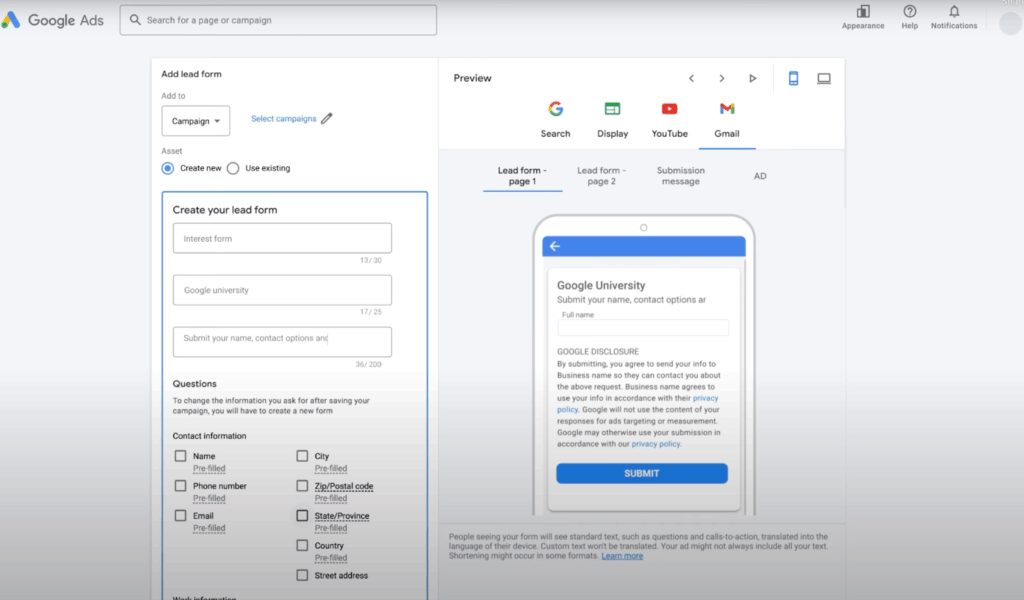
- Choose Leads as your campaign goal, then click Continue.
- Select your campaign type, such as Search, Display, Video, or Performance Max, and continue setting up your campaign.
- Enter your campaign settings, including budget, bidding, and targeting options.
- To add a lead form:
- For Search and Display campaigns, scroll to the Assets section, click More asset types, and select Lead forms.
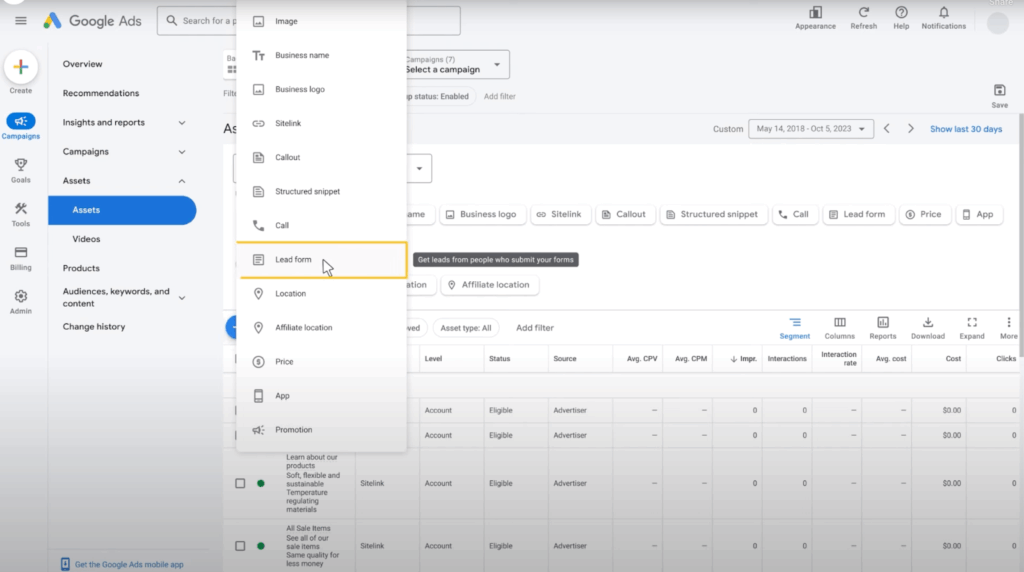
- For Video campaigns, scroll to the Lead form section and click Form.
- In the lead form editor, click Create new.
- Fill out the lead form details:
- Add a headline, business name, and a description (up to 200 characters).

Select the questions you want to ask. You must choose at least one. Standard options include:
- Name (Full name or First and last name)
- Email or Phone number (only one can be optional, not both)
- City, Postcode, State, Country
- Company name, Job title, Work email, Work phone number
This one is Optional. Click +Question to add qualifying questions. You can suggest custom ones or select from the categorized options provided by Google.
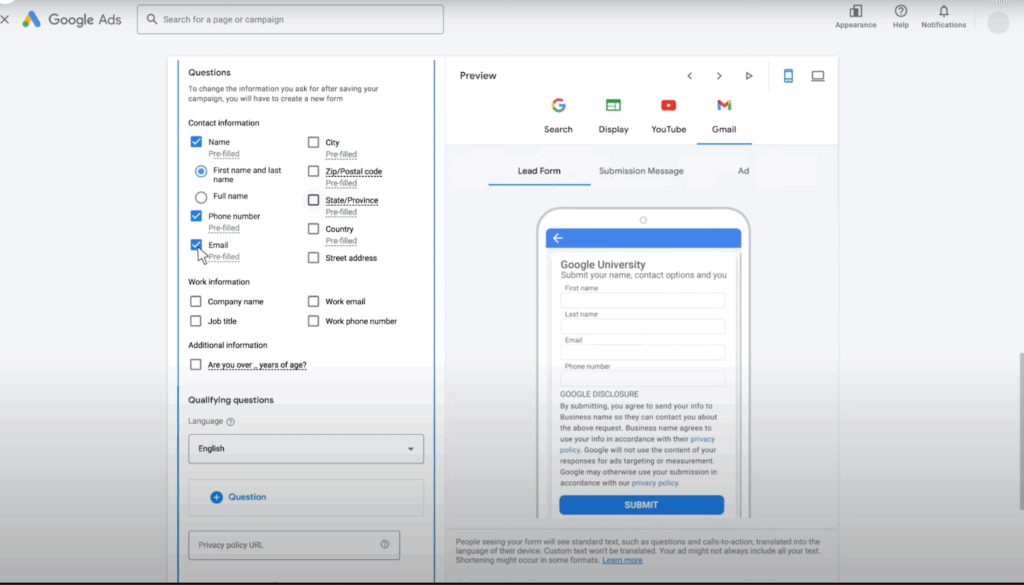
Mark selected questions as optional using the toggle switch, where applicable. Then add your privacy policy URL. This is required to collect user information.
This note applies only to Search campaigns: You can upload a background image (recommended size: 1200 x 628, 1.91:1 aspect ratio).
- Set the submission message, including:
A headline, description, call-to-action, and landing page URL if applicable. And if you want to, you can choose a submission CTA distinct from your ad CTA.
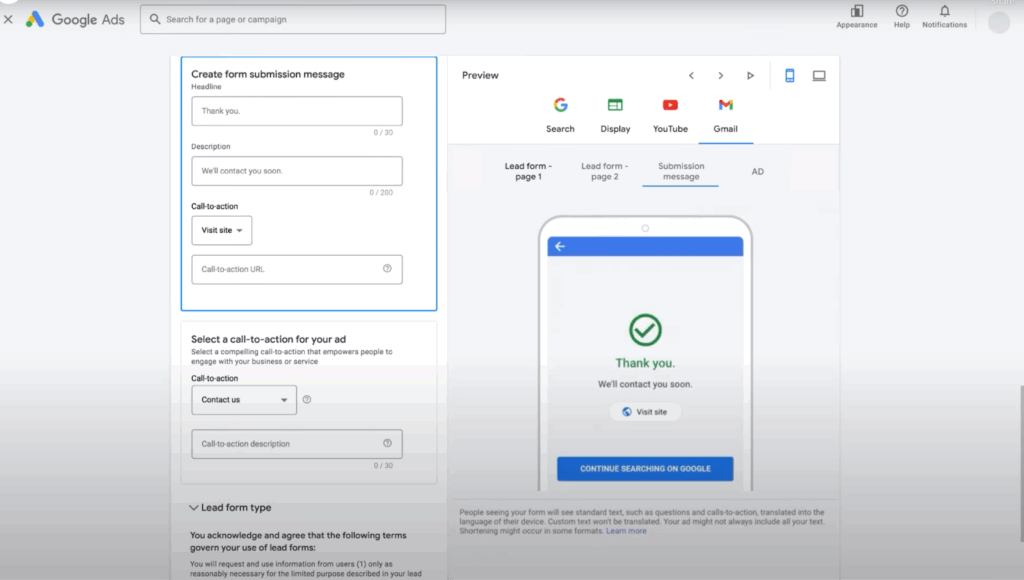
- If you want to automatically sync leads to your CRM, enter your webhook URL and Google Key in the lead delivery settings. This allows integration with platforms like LeadsBridge. Test your connection to ensure it works properly.
[widgets]
Google ads lead form+zoho crm
Google ads lead forms+hubspot
- Choose your lead form optimization setting: More qualified or More volume.
- If it’s your first time using lead forms, review and accept the Terms of Service.
- Click Save to attach the lead form to your campaign.
- Finalize and publish your campaign.
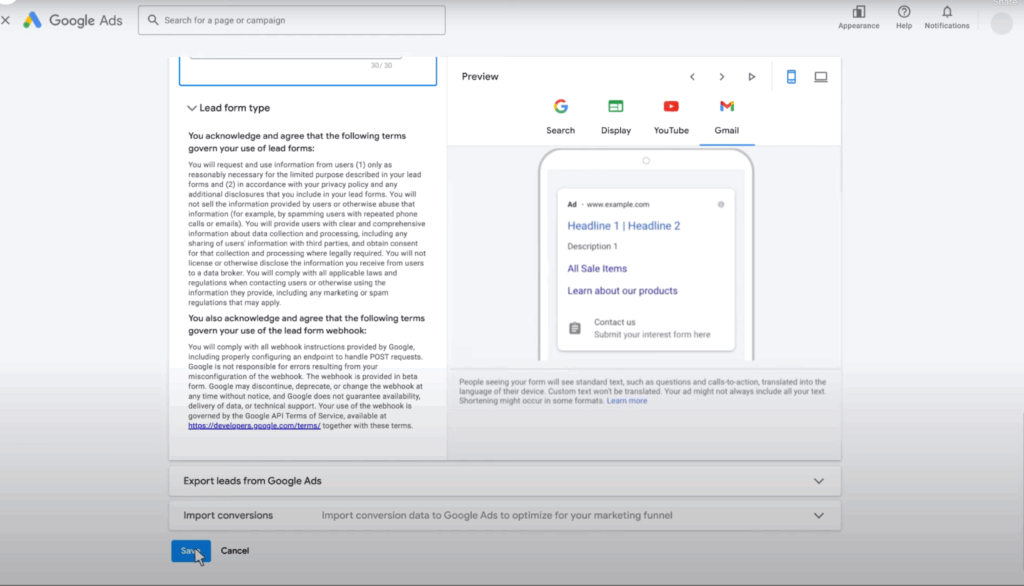
You’re now ready to start collecting and syncing leads through your lead form extension.
Here are some of our top Google Ads lead form extension integrations you can use for free.integrations you can use for free.
Google Ads “leads” vs “website traffic” campaign goals
In Google Ads campaigns, “leads” and “website traffic” are two different types of campaign goals that businesses can choose from based on their objectives. Here is the difference between the two:
- Leads campaigns collect interested prospects by prompting people to fill out a form or take a specific action. Track leads generated, conversion rate, and cost per lead.
- Website traffic campaigns drive more people to your site for increased visibility and potential conversions. Focus on metrics like clicks, impressions, click-through rate, and average cost per click.
How to improve lead quality on Google Ads
Are you wondering how to improve lead quality? Google Ads advertisers can follow the tips listed below.
Identify the most impactful actions for your business and optimize for value
- Chart the path from potential customer to completed sale. Select one pivotal moment in this pathway to focus your bidding strategy on. It’s advisable to aim for conversions at the bottom of the funnel, like the final sale amount, as it tends to represent your business’s actual economic gain more precisely.
- Allocate multiple values to your conversion tracking for optimal outcomes. We suggest utilizing dynamic values when feasible. You have the option to upload these values through various measurement tools such as Google’s gTag or by implementing enhanced conversions for lead tracking.
Implementing a Google Ads lead generation strategy
An effective Google Ads lead generation strategy is essential for attracting high-quality leads that are more likely to convert. A targeted approach ensures that ad spend is optimized and reaches the most relevant audience. Here are some quick tips to develop a successful lead generation strategy on Google Ads:
- Use lead forms: Google’s built-in lead form extensions let users submit their info right within the ad, avoiding extra steps.
- Leverage audience targeting: Use demographics, interests, and behaviors (like custom intent audiences) to reach more qualified prospects.
- Optimize ad copy and CTAs: Be clear, concise, and benefit-driven—motivating users to take the next step.
- Use conversion tracking: Monitor performance with robust tracking so you can refine and prioritize actions that produce the best leads.
Focus on the crucial metrics by employing a bidding strategy grounded in value
- Utilize Smart Bidding to fine-tune your digital marketing strategies in line with your business objectives. This powerful tool not only amplifies your conversion potential and overall business worth but also offers precise bid predictions for individual auctions by integrating a multitude of contextual signals.
Expand your marketing efforts beyond Search
- Generating leads through Google allows you to connect with your audience at any stage of their buying process, whether it’s via maps, display networks, videos, or other channels. Leverage the combination of AI-driven Search campaigns and Performance Max campaigns to enhance outcomes throughout Google’s platforms.
Choosing the best CTA extension option for Google Ads lead gen form
When setting up a Google Ads lead gen form, selecting the right call-to-action (CTA) extension is crucial for optimizing lead quality. The available CTA extension options for Google Ads lead gen forms include:
- Get quote
- Apply now
- Sign up
- Contact us
- Subscribe
- Download
- Book now
- Get offer
Choosing the appropriate CTA can affect the engagement and conversion rates of your ads. For example, if you’re promoting a service, “Get quote” or “Contact us” might be the most suitable options. For content or newsletter subscriptions, “Subscribe” or “Sign up” are effective choices.
Each CTA should be paired with compelling extension text to enhance its appeal. This short message, up to 30 characters, appears beneath your ad on the search engine results page (SERP). Examples of extension text include:
- Get quote: “Free instant quotes!”
- Apply now: “Start your application.”
- Sign up: “Join us for free.”
- Contact us: “We’re here to help!”
- Subscribe: “Exclusive updates!”
- Download: “Get your free guide.”
- Book now: “Reserve your spot.”
- Get offer: “Special discount today!”
After selecting your CTA and crafting a compelling extension text, you’ll create your lead form. This includes defining your business name, headline, description, and the specific information you want to collect from searchers.
Remember to link the privacy policy and consider using a background image to make your form visually appealing.
How much do Google leads cost
There is no defined answer to the question “How much do Google leads cost?” The cost depends on multiple factors, including:
Effectiveness of your account management.
- Nature of your industry
- Stage of your customer’s journey
- Prevailing market trends
The cost of your Google leads doesn’t depend on the format of the ad; rather, it’s determined by the purpose behind it and the level of competition for the chosen keywords.
Targeting a keyword with strong buyer intent such as “roof repair near me” will typically be more expensive than one with informational intent like “how much does it cost to repair a roof.”
As of 2025, the consolidated average CPC for Google Ads in the U.S. falls within the $5.26 range for the Search Network. In contrast, average CPC values are generally lower on the Google Display Network, with costs frequently below $1.
Average cost per lead on Google Ads
On Google Ads, the average cost per lead can range from around $30 to $50, but in competitive fields like finance and legal, it can go over $100.
Your ad quality, relevance, and targeting choices also affect how much you pay. By optimizing these factors, you can bring down costs and get more value from your ad budget.
YouTube Lead Ads available in YouTube video action campaigns
YouTube is one of the largest digital video platforms. With 2.7 billion monthly active users, it is a highly productive playground for advertisers. Over half of YouTube’s watch time happens on smartphones.
In fact, two out of three people are more likely to buy a product after watching a video about it.
Advertising on YouTube is becoming a goldmine for businesses. One standout tool is YouTube video action campaigns.
It is a budget-friendly way to drive conversions both on and off YouTube in one automated campaign.
What are the differences between YouTube video action campaigns and TrueView for action campaigns?
From April 2022, TrueView for action campaigns was auto-upgraded to video action campaigns. The key changes included:
- Ad Formats: Video action merges skippable in-stream and in-feed video ads under responsive ad groups; TrueView for action used only skippable in-stream ads.
- Inventory: Video action campaigns appear on broader surfaces, including the YouTube Home feed, while TrueView for action ads only ran on the YouTube watch page and Google video partners.
- Ad Assets: Video action allows in-feed video ads with extended headlines and descriptions, expanding beyond the standard skippable in-stream assets used in TrueView for action.
Dem Gen Campaigns on Google: What’s new in 2025
Video Action Campaigns become Demand Gen campaigns starting in Q2 2025, providing advertisers with expanded inventory (including Discover and Gmail), multi-format capabilities (video and images), and new features like Lookalike segments and Maximize Clicks bidding.
Early data shows similar costs and conversions to Video Action Campaigns, and using both video and image ads can lead to 20% more conversions at the same CPA.
When to use YouTube video action campaigns, how they work, and their benefits
Video action campaigns are a fantastic choice if:
- You want to captivate your audience and drive them to take action for your business, service, or product.
- You’re aiming to maximize scale, improve CPA performance, and boost efficiency.
- You’re already utilizing conversion tracking in your campaigns.
Here’s how they work:
- Video action campaigns deploy skippable in-stream and in-feed video ads, ensuring wider reach.
- Your ads will be showcased on YouTube and Google video partners, expanding your audience reach.
- The video content you include in the campaign should be a minimum of 10 seconds long.
- Your campaign’s ads can utilize captivating calls-to-action (CTAs), engaging headlines (both short and long), and compelling descriptions.
- To influence conversions, you have the option to add assets (e.g., site links or lead forms) or a product feed to your campaign.
YouTube video action campaigns allow you to:
- Boost conversions: Extend campaigns to reach a wider audience on and off YouTube, driving more conversions while optimizing for the lowest CPA.
- Supercharge campaign performance: Leverage YouTube, Google video partners, and beyond to reach new customers and enhance results.
- Easily scale your campaigns: Run ads on mobile, desktop, and TV in a single campaign. No need to manage separate bids and budgets for each inventory source.
How do YouTube Lead Ads work?
As part of a YouTube video action campaign, you can attach a YouTube Lead Ads form to generate leads.
These forms capture interested users and let you build remarketing lists, boost sales, and increase conversions (They work on Android!). You can add a lead form to a new or existing line item, targeting either higher-intent users or more volume.
Your existing audiences stay intact, and lead form fields remain the same. Just be sure to include your privacy policy URL for customers to review before submitting their info.

YouTube lead-generation best practices
1. Begin with a narrow audience. Target custom intent audiences, similar audiences, remarketing lists, or Customer Match first. If your lead volume is too low, slowly broaden your audience to maintain lead quality.
2. Match the language. Use the same language in both your targeting settings and lead form to avoid confusion. Stick to one language per form so potential customers can submit information easily.
3. Create compelling content. Highlight the benefits of submitting information with clear headlines, descriptions, and CTAs. For example, use “Get a quote today” and “Get a quote” if you’re promoting automobiles.
4. Optimize your CPA bid. If you already run YouTube or partner line items, start with your current CPA. For video line items, begin at 1–2 times your Display line item CPA, then gradually lower it by 10–15% to reach your ideal CPA.
5. Set a fitting budget. Ensure your daily budget is at least 20 times your CPA to allow enough conversions. If you’re using Maximize conversions, budget 20–30 times your CPA, or 10 times your effective CPA.
6. Focus on lead form submissions. If website conversions outnumber lead form submissions, consider using insertion order-level conversion tracking and optimize specifically for form fills.
How to integrate YouTube video action campaigns with your CRM
As mentioned earlier, while talking about the search lead form extension, the timing of communication with new leads is the key to driving conversions.
This means that leads coming from YouTube video action campaigns must be synced and secured in real time to the CRM or email software. Again, businesses can either retrieve their leads manually, or set up automation via a trusted integrator such as LeadsBridge. This way, they can sync leads automatically and immediately manage their marketing funnel.
LeadsBridge offers a robust integration technology with over 380 marketing tools, such as HubSpot, ActiveCampaign, Bitrix24, and many more.
Check out more of LeadsBridge’s YouTube video action campaign integrations here.
If you decide to do this process manually, remember that the lead’s CSV files are only stored for 30 days.If you decide to automate it, the webhook integration must work properly in order to correctly sync your leads.
These challenges make it imperative to rely on official Google partners such as LeadsBridge, which keeps everything running smoothly.
How to create lead ads in YouTube video action campaigns
Follow the steps below to create a lead form in a new line item:
- Start in an existing insertion order or create a new one.
- In your insertion order, click New line item.
- Pick YouTube & partners video.
- Enter the following information:
- Name for your line item.
- Select Website conversions as the line item type.
- Click Next.
- Review the Targeting section. The inventory source is set automatically. You can click Add targeting to set other line-item level targeting options. Additional types of targeting are available in the line item’s ad groups.
- Configure your line item’s settings:
- Flight dates: Pick custom flight dates or use the same dates as the line item’s insertion order.
- Budget and pacing: Set your budget and how quickly it will be spent. After you save the line item, you can’t change between daily and flight, but you can update the budget amount.
- Bidding: Choose either maximize conversions or target CPA as your bid strategy. If you choose to target CPA, set your target bid.
- Bid adjustment: (Optional) Select a mobile, desktop, or tablet bid adjustment to set if your line item can serve on these devices.
- Frequency cap: (Optional) Select the line item’s frequency cap.
- In the Lead form section, click New lead form.
- Enter your Business name and Call-to-action.
- Add a Headline and Description.
- Choose the information you want to collect in the lead form. You’ll need to select at least one option to continue. All fields you select are required for the person completing the form.
- Name (can be customized as First name and last name or Full name)
- Phone number
- City
- Zip / Postal code
- State / Province
- Country
- Company name
- Job title
- Work email
- Work phone number
- If someone is signed in to their YouTube account and they see your lead form, the following fields are pre-filled when they open the lead form: Name, Email, Phone number, and Zip code.
- Add the URL to your privacy policy. A privacy policy is required to collect information.
- Add a Post-submit headline and Post-submit description that appears after people submit their information.
- Click Next.
- Select the type of lead form you want to show people. The option you choose may affect the cost per lead and the number of leads collected. You can change the lead form type at any time.
- Higher intent: Choose this option if you want leads who are more likely to be interested in your product or service. The form contains more steps to submit and may lead to less leads as a result.
- More volume: Choose this option if you want more leads. You may see more leads, but the people included in your leads may be less likely to be interested in your product or service.
- Enter your webhook URL and key in the lead delivery section. A webhook links your lead form to your customer relationship management system.
- To agree to the terms of service, click I agree.
- Click Save.
If you want to add a lead form to an existing line item, follow the steps below:
- Navigate to your existing insertion order. Click the name of the line item that you want to add the lead form to.
- Click Line item details.
- In the Lead form asset section, click New lead form.
- Create the lead form, following the instructions in the Create a lead form in a new line item section.
- Click Save. If a lead form is attached to an existing line item, it will run once the form is approved. You’ll be able to see the review status of your lead form under Lead form in your line item settings.
If you wish to send your new leads automatically from YouTube video action campaigns to your CRM with LeadsBridge, you can enable lead delivery by webhook.
You just need to copy-paste the Webhook URL and Google Key that you received while creating your bridge on the LeadsBridge app.

For more detailed instructions on how to integrate YouTube video action campaigns with your CRM, follow this step-by-step guide.
Would you like to try some of these integrations for free? Here are some of our most popular bridges, which are included in our freemium plan:
To find your favorite bridges, explore all the possible integrations with YouTube video action campaigns here.
Using Lead Forms in Google Discovery Campaigns
After discontinuation of Google+ a few years back, many experts assumed that Google was falling short when it came to top-of-the-funnel ad revenue. Fortunately, Google introduced Google Discovery Ads back in 2019 and, soon after, made it available worldwide.
Using Lead Forms in Discovery campaigns makes it easier for advertisers to capture individuals with the correct interests (matching with their target audiences).
What is Google Discovery Ads?
Google Discovery Ads are visually-driven ads that show up in the Google Discovery Feed, YouTube home feed, and Gmail. Their look changes based on the platform, emphasizing visuals to attract attention.
Unlike traditional ads focused on search history, Discovery Campaigns target users based on their interests and the data gathered as they interact across Google’s ecosystem.
Benefits of running Google Discovery Ads
Google Discovery Ads appear across Discover, YouTube, and Gmail, reaching massive audiences. This includes Discover’s 1 billion monthly users to YouTube’s 2.7 billion.
By showing visually appealing, highly relevant content, they capture buyers at each stage of their journey, boosting conversions and brand visibility.
Originally limited to the Google Discover app, they now show up in the YouTube Home feed and Gmail’s Promotions tab, making it easy to deliver the right message to the right people—all without being pushy.
Let’s look at an example for each of the three main Google properties: YouTube, Discover, and Gmail
An effective marketing strategy and the right automation tools are essential to getting the best out of Google Discovery Ads. As a result, you can capture more qualified prospects and increase your conversion rates.
However, keeping track of all that goes on with your leads and campaigns can be challenging. The best way to turn the odds in your favor is to use a third-party integration like LeadsBridge to automate the process.
Learn how integrations can help you build a Google Ads strategy that converts here.
Google Discovery Ads examples
Gmail
Gmail is one of the popular locations for discovery ads to be placed, typically being found within the “promotions” or “social” tabs, as seen below;
Once you click on these ads, they will open in the same format as a general email, displaying further details regarding the offer from the brand.
Google App
If you have the official Google app downloaded on your mobile and have the “discover” feature turned on, you will have seen a plethora of discovery ads while scrolling.
The Discover feed features a variety of content that is tailored to each user based on their previous web searches, their interests, and what items they have saved. Take a look at these Google Ads Discovery examples from mandmdirect and Ted Baker.
YouTube
The YouTube app is a common host for Google Discovery ads, typically appearing as you scroll through the “home” tab to explore videos.
To help you differentiate between these and videos, you will see a yellow ad box on display in the left corner.
This Google Discovery ads example, by Fabletics, perfectly highlights how brands typically use this platform to advertise their offering.
If you’d like to see some Google Ads examples to get inspired, check out this article: Google Ad examples that work.

Google Discovery Ads best practices
Much like any advertising strategy, garnering success with Google Discovery Ads requires following a number of best practices that set a strong foundation for driving campaign results and increasing conversions.
Let’s take a look at the four Google Discovery Ads best practices that you need to keep in mind going forward.
1. Creative quality
Your Discovery ad could be someone’s first impression of your brand—so make it count. Use only high-resolution images that clearly show your product. Avoid awkward cropping, cluttered backgrounds, and excessive text.
2. Grab attention
Discovery ads often reach people who aren’t actively searching for your brand. Capture their interest with eye-catching headlines, engaging copy, and a focus on common pain points to spark new curiosity.
3. Be attentive with “Automatic targeting”
Google’s automatic targeting can find new audiences likely to convert. But if you only want to remarket to your existing list, turn off Optimized targeting in your ad group settings, since it’s turned on by default.
4. Don’t optimize too early
Give your campaign enough time (usually a couple of weeks) to gather data and let your bidding strategy settle. Only make immediate changes if something is clearly incorrect; otherwise, wait before drawing conclusions or tweaking your ads.
YouTube in-feed video ads
YouTube in-feed video ads, previously known as TrueView video discovery ads, position your brand, product, or service alongside captivating YouTube content that is highly likely to be viewed by your ideal audience.
In-feed video ads show up in YouTube search results, YouTube Watch Next, and the YouTube app’s Home feed, embracing the perfect opportunity to increase your reach and engage with potential customers.
In-feed video ads on YouTube captivate viewers with an enticing image thumbnail, a captivating headline, and up to 2 brief lines of text (based on ad placement).
When users engage with the thumbnail, they are instantly transported to the YouTube watch page specifically designed for the ad. Notably, in certain environments, hovering over the thumbnail seamlessly initiates a muted autoplay of the video ad.
Benefits of YouTube in-feed video ads
In-feed video ads on YouTube help boost brand consideration by:
- Showing up where viewers are already exploring related videos
- Scrolling the Home feed
- Or, searching for specific topics.
These ads link to a YouTube watch page, just like organic videos, except for a small “ad” tag indicating they’re paid.
They also deliver helpful information to interested viewers, encouraging them to subscribe, share, or watch more of your content. With CPV (Cost-Per-View) bidding, you only pay when someone chooses to watch your ad. This takes place once it fully loads on their browser or YouTube app.
The difference between in-stream and in-feed video ads
The terms for in-stream and in-feed video ads are often used interchangeably, but they are different.
In-stream ads can be either skippable or non-skippable:
- Skippable in-stream ads appear before, during, or after other videos. Once 5 seconds pass, viewers get to choose whether to skip the ad or keep watching.
- Non-skippable in-stream ads are 30 seconds or less and are also strategically placed before, during, or after other videos, but do not show the option to skip the ad.
Below you can find examples of how both in-stream ads appear on YouTube.
On the other hand, in-feed video ads don’t cut through the streaming. Instead, they are suggested to the user in their search results. The user willingly chooses to click on these ads to watch them.
In-feed video ad examples
When browsing YouTube, you’ve undoubtedly come across an in-feed video ad example. These ads are videos that say “ad” next to them. Here is how it looks:
As you can see, the ad meets the criteria we mentioned above: a thumbnail and some text. Because of the nature of YouTube’s in-feed video ads, this video is mixed in with the regular videos.
Based on the intent of the user, YouTube (or Google) automatically recommends something that its ad algorithm deems relevant. Using this as an example, the algorithm is pretty spot-on.
What are Google Ads enhanced conversions for leads?
Google Ads Enhanced Conversions for Leads helps improve lead tracking and conversion accuracy. It works by automatically sending important data (like a user’s email address and a unique click ID, called GCLID) to Google when someone submits a lead form on your website. This function allows you to track leads, match them to their actions, and optimize your ads for better results.
How does enhanced conversions for leads works?
First, you need to add a Google tag (via Google Ads, Tag Manager, Analytics, or Campaign Manager 360) to your website’s lead form. When a user submits a lead form, the tag sends the user’s data, such as their email address, along with the GCLID, to Google.
Later, when the user converts (e.g., makes a purchase), this data is uploaded to Google Ads either automatically or through the API. Google then matches the uploaded lead data with your conversion data. This helps you track which ads generated the leads.
Simple steps to set up enhanced conversions for leads
Step 1: Enable conversion tracking.
- Make sure your Google Ads account has conversion tracking enabled.
- If it’s not set up, create a “conversion action” in Google Ads. Also, ensure that the conversion action type is set to “UPLOAD_CLICKS.”
Step 2: Accept customer data terms.
- Opt-in to Enhanced Conversions for Leads and accept the necessary customer data terms in your Google Ads account settings.
Step 3: Configure Google tagging.
- Set up the Google tag on your website. You can use tools like Google Tag Manager or follow Google Ads’ tagging instructions to integrate enhanced conversions with your lead forms.
Something to keep in mind. Make sure your tags are set up properly to capture lead data accurately. Also, use the right conversion type (choose “UPLOAD_CLICKS”)so enhanced conversion tracking works as it should. After everything is set up, give your campaigns some time to collect data before tweaking anything.
Why use enhanced conversions for leads?
- It helps connect your leads to their actions, giving you a clearer picture of what’s working in your campaigns.
- Google Ads can then focus on the actions that generate the most valuable leads.
- It’s easy to implement using Google’s tools like Tag Manager or Google Ads UI.
Key takeaways
Advertisers must constantly adapt to changes in consumer behavior. Over half of people browse the web from mobile, one of the best ways for a business to drive leads is with native lead generation ads, which are specifically designed for mobile navigation.
Google Ads lead form extensions and YouTube video action campaigns make it easy for users to submit a form, all without interrupting their navigation experience, like being directed to another landing page.
However, businesses should also implement more in-depth analytics to track real conversions. These assessments should analyze lead form extensions and video action campaigns performance to understand which efforts are generating the highest returns.
To do so, it’s key to integrate their CRM with their Google Ads account, ideally through an official Google partner and automation platform, such as LeadsBridge.
Discover all the possible integrations for Google Ads lead form extensions and YouTube Trueview for Action Form Ads to get the most out of your marketing strategies.





































